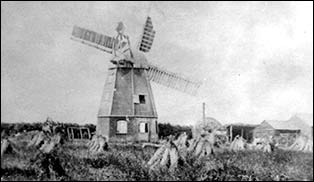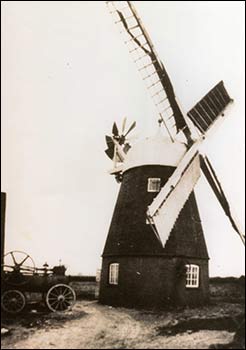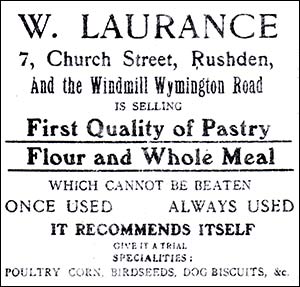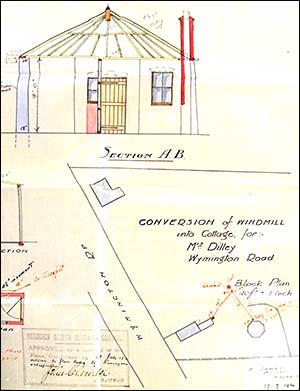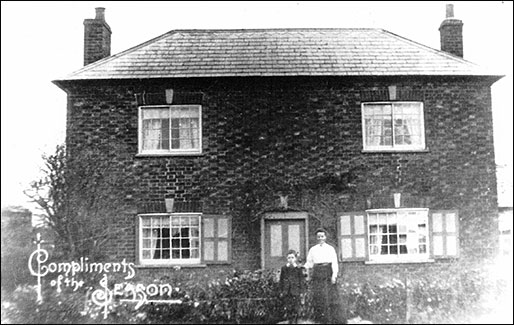|
||||||||
| RDHS ‘Risdene Echo’, Volume 8 Number 3 June 1999, by Talbot K Green |
||||||||
|
Green's Windmill
|
||||||||
|
||||||||
|
|
||||||||
| The story of Green's Windmill begins on 23rd September 1793, when James Green, miller of Kimbolton, married Ann Knight in the parish church at Rushden, witnessed by her father Samuel Knight and Thomas Presland. Their first son, William, was born at Kimbolton on 4th November the following year - then came Elizabeth (14th Jan. 1797), James (27th Oct. 1800), Mary (12th Jan. 1807), Edward (buried 16th Feb. 1810) and Edward (22nd Jun.1811) - all but the first Edward having their births recorded in the Kimbolton Dissenters' (Baptists) Meeting House Book. Because it was the custom to name children after their immediate ancestors I'll refer to father and son as James I and II - as will become clear, William needs to become William I whilst the surviving Edward has to be II. William I is the first to resurface for, on 18th Nov. 1823, the Manorial Court Baron of Rushden was informed that three years before (on 4th Nov. 1820), he had paid £35 to Joseph Manton, farmer, of Irchester, a customary tenant of Rushden Manor, for the lease of a quarter acre of land alongside both the County Boundary and the Wymington road. He is described as a miller and resident in Rushden and the foundations of what was definitely going to be a windmill had begun to appear; the foreman of the Homage (council) given this revelation was none other than the baker Samuel Achurch who, with his son William, ran the town's only existing windmill on the slope above Duck Street, south of the present 'Oakley Arms'. Now confident in his career, William I had married Mary Ann Austin at Podington Church on the previous 21st of May. However, at a Manorial Court held on 12th Dec. 1825, it was reported that, three days before, he had surrendered his lease to the Lord of the Manor - none other than His Gracious Majesty, King George IV, Rushden Manor being part of the lands forming the Duchy of Lancaster - in favour of his brother James II; the latter paid £265 for this, funding it by a loan of £140 from William Main, a fanner of St Neots. But the land now supported a corn windmill, "lately erected" and fully equipped "with millstones, sails, sailcloths, Going and other gears, machinery" and all the "other tackle used therein". William I had gone off to Tilbrook and so James II was admitted the new customary tenant by Edward Bouverie the Deputy Steward, being granted the ground and windmill etc "to him, his heirs and assigns at the will of the Lord according to the custom of the Manor."
The land round the windmill only amounted to 27 perches (1080 sq.yards) so, when Joseph Manton, the owner of the plot from which it had been carved, died in 1827, James I bought it and another plot for £100 from Manton's heirs. The grounds now extended to 2 acres and 19 perches, i.e. 10,440 sq.yds. Although it doesn't explicitly say so, James must have given them to his son after the Court session of 19th May 1827; however, from the autumn of 1833 at least, James II was nominally resident in Kimbolton and had let an Edward Green - almost certainly his paternal uncle and hereinafter called Edward I - occupy his Wymington road windmill. He in turn, I assume, is the E GREEN MILLER who carved his name on a beam in Tilbrook West windmill in 1826. On the strength of the rental value of this landholding, James II got a vote in Rushden under the revised franchise following the 1832 Reform Act. James II's family developed as follows:- James III was born in 1827; Charles in 1831; Ann in 1832-3; William II on 29th October 1835; and Elizabeth in 1841 after the Census had been conducted on June 5th-7th. Four of them were Rushden-born but I think my great-grandfather William II's birth at Houghton Conquest is best explained by the fact that, in his mother's family, her next-born brother Thomas went to work there as an agricultural labourer and married Elizabeth Thorowgood in 1831. Either Martha found her sister-in-law a congenial companion for her confinement, or William decided to put in an unexpectedly early appearance whilst his mother was visiting them - we shall never now know. What is quite clear is that James, his father, did not work the tower mill which still stands as an unstable shell out to the NE of the village; the miller since the 1820s had been George Cheshire/Cheshur, from Barton-in-the-Clay, who had married a girl called Susan from Marston Moretaine and worked Houghton Conquest mill until the 1860s. William I moved on from Tilbrook to Olney, where his first son John was born around 1829. His second child William II was born at Weston (Underwood) in 1832, while James IV, Elizabeth and George II arrived when their father worked the tower mill - now part of a house off Moulton Road at Kingsthorpe - during the later 1830s. In his book on Northants windmills, Trevor Stainwright comments that Kingsthorpe and Green's mill, Rushden, share a unique choice of sweeps; perhaps William I was responsible.
From then on I cannot trace the story of James Green II. A family legend is that, following his death, a lawyer swindled his widow out of the proceeds from selling his leases by going off to America with them. I had my suspicions about John Costin, the 'attorney' handling the 1825 sale from William to James, since his uncommon name actually occurs amongst the applicants for naturalization in Virginia in 1857. But he turns out to have been only an attorney's clerk who lived on in Kimbolton until well past the critical time. Moreover, I cannot find any other windmill leases in the name of James Green II of Kimbolton in the obvious places prior to 1842; his cousins, by contrast, occupied a number over the years. What is certain is that, by the time of the 1851 Census, Martha was a widow and in receipt of Parish relief - she and her son William, now 14, are classified as paupers. It is for reasons of personal embarrassment like this that the intimate family details required by the Census enumerators remain secret for 100 years. The Minute or Admissions Books for the 1840s and '50s of Wellingborough Poor Law Union have not been preserved amongst the papers at Northampton Record Office, so nothing about how she came to be admitted can be told. Edward Green I, formerly the tenant miller in Wymington Road, had married Mary Philips at St Andrew's church, Kimbolton, on 24th October 1803, and died in the summer of 1848. The censuses show their children's birthplaces were:- Joseph in c1808 at Gamlingay, Cambs; Hannah in c1810 at Brampton, Hunts; and George I in c!815 at Huntingdon. It may not be insignificant that there were two windmills at Gamlingay, one standing at least until the 1960s, whilst the watermills at Brampton and Huntingdon survive: even if the latter's a Victorian steam replacement for that shown on the O.S. Old Series draft map. And we have his probable presence at Tilbrook West mill in 1826: so he was a person who shifted around during his working life as did William I. Going back to 1851, the widow Martha Green(48) lacemaker (pauper), living in Rushden "east of the Town Street", had with her unmarried children James(23) a coal dealer, Charles(21) shoemaker, William(14) shoemaker(pauper) and Elizabeth(ll) lacemaker. Anne was in service at Ward's farm, Rushden Road, Irchester. Joseph Green(43) lived in No.5 Lodge in an area "west of the Town Street" which included "The Hall, Adam Lodge, Greens' Windmill, Achurches' Windmill and Marshalls' Lodge." With him were his wife Mary(40) and son Benjamin (l), widowed mother Mary(72) born in Kimbolton, sister Hannah(41) and niece Jane(18) born - like his wife and son - in Rushden. His brother George had married and set up his own household in the town with his daughters Elizabeth(6), Mary Ann(3) and Amelia(l); unfortunately his wife was already dead and the widow Maria Childs from Wymington acted as housekeeper. The girls were born at Wellingborough, Wymington and Rushden respectively: like his brother, his trade is miller and I assume they ran Greens' Mill together because the Achurches still ran theirs: later it became Moores' and then Foscutts'. Across the county boundary, Thomas Perkins and his wife Jane are found living at the "End of the Village" in Wymington. They have the wife's cousins Thomas and Frederick Green lodging with them, the three men now reverted to 'Ag.Labs'. Although close to the windmill, there is no sign of their involvement with it.
But the mill continued in use. Stainwright records that, in the years up to WWI, it was owned by a Mr & Mrs Lewis: clearly Deborah and her husband Wilfred (one of seven brothers all of whom their father, blacksmith Charles Lewis, endowed with forenames starting with W). To run it they employed millers like George Walker (1898), William Chapman (1903), and William Laurance (1906-10), while youngsters Fred and Bill Dilley used to help out until they went off to fight in France, where Fred lost his life. The mill ceased to operate around 1915 and, in 1920, the sails and milling machinery were removed and the wooden tower dismantled. When the base was put up for sale by Mrs Lewis, Bill Dilley's eldest brother John bought it for £300 and, by getting a builder to put on the hexagonal roof, turned it into a cottage. The extensions were added in the 1970s. Wilfred's death was registered in the first quarter of 1927, and his wife's approximately two years later, both having been born in 1854/5.
Note: This article is based on a fuller history of my Green ancestors printed in Records of Huntingdonshire Vol.3 No.6 (1997-98), which gives references and acknowledgments. |
||||||||
|
|
||||||||
